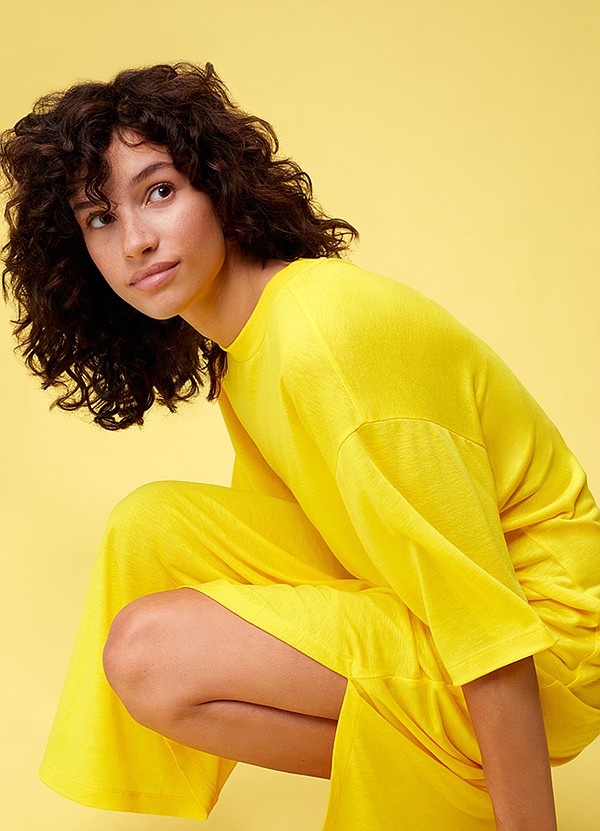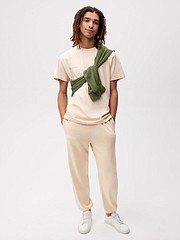With its new FRUT FIBER and PLNT FIBER offerings, Pangaia is providing alternatives to pollutive textiles by maintaining a soft hand, performance and appearance, while reducing waste and emissions.
PLNT-ING GOOD
Fabric Alternatives PLNT FIBER and FRUT FIBER Introduced by Pangaia
Seeking to combat the negative impacts of pollutive textiles in the fashion industry, materials-science company Pangaia unveiled its latest innovations in the fabric space. Manufactured from plant fibers, Pangaia’s PLNT FIBER and FRUT FIBER were introduced as the company commits further to a mission of moving apparel manxufacturing away from nonorganic cotton and synthetics created from petroleum-based resources.
“The future of sustainability in fashion lies in a return to the bio-economy through promotion of bio-diversity and regenerative agricultural systems,” said Pangaia’s Chief Innovation Officer Dr. Amanda Parkes. “FRUT FIBER and PLNT FIBER are Pangaia’s latest innovations, which embody our commitment to these principles and work toward science-based targets for carbon reduction.”
As the apparel industry moves toward greener, more ecologically sound practices, Pangaia is working to provide options to its clients to fulfill the demand for more-sustainable goods originating in its customer base. While Pangaia recognizes the important role that traditional fabrics have played, it is working to replicate in alternative materials the characteristics that make less eco-friendly textiles attractive.
The London-headquartered Pangaia sought renewable resources when developing its new blends to create the more-sustainable textiles. Its PLNT FIBER is created from bamboo, Himalayan nettle, eucalyptus and seaweed. These plants were chosen as they require no pesticides, fertilizers or irrigation during cultivation. In addition to the low-maintenance approach to growing these plants, consistent harvesting of bamboo and nettle promote growth, thereby affording faster cultivation.
“We are using the first blends we developed as replacements for cotton knits for basics like T-shirts, track suits and loungewear. This is a huge market we have to impact. Each type of fiber offers unique performance and functional characteristics, and we are continuing to expand our textile blends in hand feels ranging from rugged to silky,” Parkes explained. “We are also expanding FRUT FIBER and PLNT FIBER into wovens.”
For its FRUT FIBER, Pangaia relied on bamboo Lyocell blended with fibers sourced from fruit byproducts. As an alternative to relegating pineapple-leaf and banana-leaf fibers to the landfill or burning them as a method of disposal, using these materials to create textiles reduces waste and carbon emissions.
“By using renewable and fast-growing plants, the brand helps to reduce the fashion industry’s reliance on cotton and synthetics by diversifying textile blends,” Parkes said. “Additionally, our lyocell process for bamboo production is completed in a closed-loop system where the chemicals are fully reclaimed.”
With the recent release of its PLNT FIBER and FRUT FIBER alternatives, Pangaia is also relying on technology to help close the loop on its supply chain for textile manufacturing.
Partnering with EON, developer of the CircularID Protocol, Pangaia added digital passports to each of its PLNT FIBER and FRUT FIBER products in order to move the needle forward toward circularity. These passports work through a QR code with a cloud-hosted digital twin that reveals the supply-chain story of each garment. The technology first appeared in Pangaia’s Horizon collection to promote transparency, traceability and circularity. Through this commitment to sourcing renewable, greener resources and blending these initiatives with technology to promote circularity, Pangaia is maintaining its commitment to a mission it refers to as “high-tech naturalism.”
Photos courtesy of Pangaia.

























